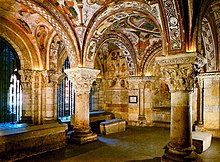Basilica of San Isidoro, León
This article has multiple issues. Please help improve it or discuss these issues on the talk page. (Learn how and when to remove these template messages)
|

The Basílica de San Isidoro de León is a church in the city of León, Castile and León, Spain, located on the site of an ancient Roman temple. Its Christian roots can be traced back to the early 10th century when a monastery for Saint John the Baptist was erected on the grounds.
In 1063 the basilica was rededicated to Saint
In 1188, the Cortes of León were held in here. It was the first sample of modern parliamentarism in the history of Europe, according to the UNESCO and John Keane's book The Life and Death of Democracy.
History

The original church was built in the pre-
sisters on the site.Following the conquest of the area by
Alfonso's daughter, the
The church was rebuilt as a basilica and rededicated by Ferdinand I and Sancha in 1063. They renamed it San Isidoro in honor of St. Isidore, whose remains were transported to León.[1][2]
Queen Sancha chose the new monastery as the site of the royal burial chapel. Today eleven kings, numerous queens and many nobles lie interred beneath the
In 1072, after the death of Sancho,
The basilica is still a collegiate foundation and the canons' office is celebrated each day.
Description

Basilica
Built mostly in the Romanesque style, the basilica has had major additions in the styles of many succeeding centuries including the Gothic. The arches on the crossing of the transept hark back to Islamic art. However the many styles merge into a harmonious whole.
The carved tympanum of the Puerta del Cordero is one of the basilica's most notable features. Created prior to 1100, this romanesque tympanum depicts the sacrifice of Abraham.

Royal Pantheon
Or the Pantheon of the Kings of León. This funeral chapel of the
are in an exceptional state of preservation and consist of an ensemble of New Testament subjects along with scenes of contemporary rural life.Museum
This contains numerous examples of early medieval art including jewelled chalices and works of ivory and precious metal. The library holds 300 medieval works, numerous manuscripts as well as mozarabic bible dating from 960 and a Latin version transcribed in the seventh century. There is also a text of the seventh century law code of the Visigothic rulers of pre-conquest Spain. The Chalice of Doña Urraca is one of the most important pieces in this Museum.
References
- ^ "The Basilica". Turismo de León. Retrieved 18 February 2024.
- ^ Caldwell (1986), p. 19.
- ^ Caldwell (1986), p. 21.
Bibliography
- Caldwell, Susan Havens (1986). "Urraca of Zamora and San Isidoro in León: Fulfillment of a Legacy". Woman's Art Journal. 7 (1): 19–25. JSTOR 1358232. Retrieved 18 February 2024.
External links
- Círculo Románico – Visigothic, Mozarabic and Romanesque art in all Europe
- Visualisation of romanesque building sculpture in an architectural context
- Photos
- Basilica de San Isidoro Photo Page in Paradoxplace
- The Art of medieval Spain, A.D. 500–1200, an exhibition catalog from The Metropolitan Museum of Art Libraries (fully available online as PDF), which contains material on Basilica of San Isidoro (#108, #89, #108–110, #111, #113, #117–118, #150 and pp. 121–131, 162–173)
